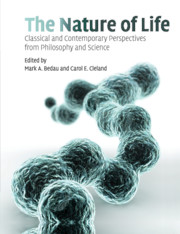Book contents
- Frontmatter
- Contents
- Preface
- Acknowledgments
- Sources
- About the authors
- Introduction
- SECTION I CLASSICAL DISCUSSIONS OF LIFE
- SECTION II THE ORIGIN AND EXTENT OF NATURAL LIFE
- 8 The origin of life: a review of facts and speculation
- 9 Small molecule interactions were central to the origin of life
- 10 Are the different hypotheses on the emergence of life as different as they seem?
- 11 The universal nature of biochemistry
- 12 Is there a common chemical model for life in the universe?
- 13 Searching for life in the universe: lessons from Earth
- 14 The possibility of alternative microbial life on Earth
- 15 Introduction to the limits of organic life in planetary systems
- SECTION III ARTIFICIAL LIFE AND SYNTHETIC BIOLOGY
- SECTION IV DEFINING AND EXPLAINING LIFE
- Supplementary bibliography on life
- Index
- References
14 - The possibility of alternative microbial life on Earth
Published online by Cambridge University Press: 10 November 2010
- Frontmatter
- Contents
- Preface
- Acknowledgments
- Sources
- About the authors
- Introduction
- SECTION I CLASSICAL DISCUSSIONS OF LIFE
- SECTION II THE ORIGIN AND EXTENT OF NATURAL LIFE
- 8 The origin of life: a review of facts and speculation
- 9 Small molecule interactions were central to the origin of life
- 10 Are the different hypotheses on the emergence of life as different as they seem?
- 11 The universal nature of biochemistry
- 12 Is there a common chemical model for life in the universe?
- 13 Searching for life in the universe: lessons from Earth
- 14 The possibility of alternative microbial life on Earth
- 15 Introduction to the limits of organic life in planetary systems
- SECTION III ARTIFICIAL LIFE AND SYNTHETIC BIOLOGY
- SECTION IV DEFINING AND EXPLAINING LIFE
- Supplementary bibliography on life
- Index
- References
Summary
INTRODUCTION
Finding a form of life that differs in its molecular architecture and biochemistry from life as we know it would be profoundly important both from a scientific and a philosophical perspective. There is compelling evidence that life as we know it on Earth today shares a last universal common ancestor (LUCA; Woese 1967, 2004). It is unlikely that LUCA was the earliest form of life on Earth since it was already quite sophisticated, having nucleic acids and proteins, as well as complex metabolic processes. In short, life as we know it represents a single example of a fairly advanced stage of life. One cannot safely generalize from a single example to all life, wherever or whenever it may be found. Indeed, in the absence of additional examples of life we are in a position analogous to that of a zoologist trying to formulate a theory of mammals based only upon their experience with zebras. It is unlikely that she will focus on their mammary glands since they are characteristic only of the females. Yet the mammary glands tell us more about what it means to be a mammal than the ubiquitous stripes seen in both male and female zebras. Finding a form of life having a different molecular architecture and biochemistry would help us to understand the nature of life in general—the processes that led to its emergence and the various forms it may take, whether on the early Earth or elsewhere in the Universe.
- Type
- Chapter
- Information
- The Nature of LifeClassical and Contemporary Perspectives from Philosophy and Science, pp. 198 - 209Publisher: Cambridge University PressPrint publication year: 2010



